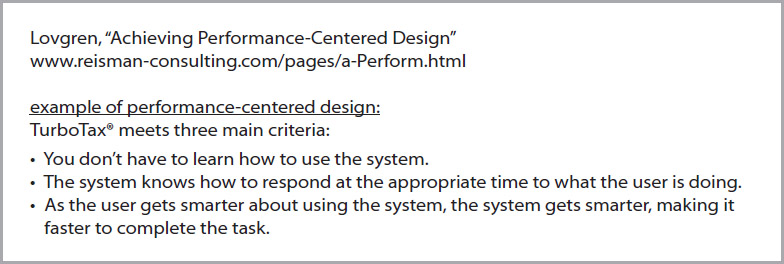Paraphrasing
Printed Page 607-609
Paraphrasing
A paraphrase is a restatement, in your own words, of someone else’s words. If you simply copy someone else’s words—even a mere two or three in a row—you must use quotation marks.
In taking notes, what kind of material should you paraphrase? Any information that you think might be useful: background data, descriptions of mechanisms or processes, test results, and so forth.
Figure A.1 shows a paraphrased passage based on the following discussion. The author is explaining the concept of performance-centered design.
Original Passage
In performance-centered design, the emphasis is on providing support for the structure of the work as well as the information needed to accomplish it. One of the best examples is TurboTax®, which meets all the three main criteria of effective performance-centered design:
• People can do their work with no training on how to use the system. People trying to do their income taxes have no interest in taking any kind of training. They want to get their taxes filled out correctly and quickly, getting all the deductions they are entitled to. These packages, over the years, have moved the interface from a forms-based one, where the user had to know what forms were needed, to an interview-based one that fills out the forms automatically as you answer questions. The design of the interface assumes no particular computer expertise.
• The system provides the right information at the right time to accomplish the work. At each step in the process, the system asks only those questions that are relevant based on previous answers. The taxpayer is free to ask for more detail or may proceed through a dialog that asks more-detailed questions if the taxpayer doesn’t know the answer to the higher-level question. If a taxpayer is married filing jointly, the system presents only those questions for that filing status.
• Both tasks and systems change as the user understands the system. When I first used TurboTax 6 years ago I found myself going to the forms themselves. Doing my taxes generally took about 2 days. Each year I found my need to go to the forms to be less and less. Last year, it took me about 2 hours to do my taxes, and I looked at the forms only when I printed out the final copy.
This paraphrase is inappropriate because the three bulleted points are taken word for word from the original. The fact that the student omitted the explanations from the original is irrelevant. These are direct quotes, not paraphrases.

This paraphrase is appropriate because the words are different from those used in the original.
When you turn your notes into a document, you are likely to reword your paraphrases. As you revise your document, check a copy of the original source document to be sure you haven’t unintentionally reverted to the wording from the original source.

Figure A.1 Inappropriate and Appropriate Paraphrased Notes
Source: Adapted from Lovgren, 2000: www.reisman-consulting.com/pages/a-Perform.html.
Paraphrasing Accurately

- Study the original until you understand it thoroughly.
- Rewrite the relevant portions of the original. Use complete sentences, fragments, or lists, but don’t compress the material so much that you’ll have trouble understanding it later.
- Title the information so that you’ll be able to identify its subject at a glance. The title should include the general subject and the author’s attitude or approach to it, such as “Criticism of open-sea pollution-control devices.”
- Include the author’s last name, a short title of the article or book, and the page number (if any) of the original. You will need this information later in citing your source.